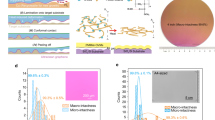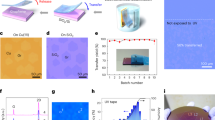Abstract
Recent advances in chemical vapour deposition have led to the fabrication of large graphene sheets on metal foils for use in research and development. However, further breakthroughs are required in the way these graphenes are transferred from their growth substrates onto the final substrate. Although various methods have been developed, as yet there is no general way to reliably transfer graphene onto arbitrary surfaces, such as ‘soft’ ones. Here, we report a method that allows the graphene to be transferred with high fidelity at the desired location on almost all surfaces, including fragile polymer thin films and hydrophobic surfaces. The method relies on a sacrificial ‘self-releasing’ polymer layer placed between a conventional polydimethylsiloxane elastomer stamp and the graphene that is to be transferred. This self-releasing layer provides a low work of adhesion on the stamp, which facilitates delamination of the graphene and its placement on the new substrate. To demonstrate the generality and reliability of our method, we fabricate high field-strength polymer capacitors using graphene as the top contact over a polymer dielectric thin film. These capacitors show superior dielectric breakdown characteristics compared with those made with evaporated metal top contacts. Furthermore, we fabricate low-operation-voltage organic field-effect transistors using graphene as the gate electrode placed over a thin polymer gate dielectric layer. We finally demonstrate an artificial graphite intercalation compound by stacking alternate monolayers of graphene and 2,3,5,6-tetrafluoro-7,7,8,8-tetracyanoquinodimethane (F4TCNQ). This compound, which comprises graphene sheets p-doped by partial hole transfer from the F4TCNQ, shows a high and remarkably stable hole conductivity, even when heated in the presence of moisture.
This is a preview of subscription content, access via your institution
Access options
Subscribe to this journal
Receive 12 print issues and online access
$259.00 per year
only $21.58 per issue
Buy this article
- Purchase on Springer Link
- Instant access to full article PDF
Prices may be subject to local taxes which are calculated during checkout





Similar content being viewed by others
References
Geim, A. K. & Novoselov, K. S. The rise of graphene. Nature Mater. 6, 183–191 (2007).
Li, X. et al. Large-area synthesis of high-quality and uniform graphene films on copper foils. Science 324, 1312–1314 (2009).
Chae, S. J. et al. Synthesis of large-area graphene layers on poly-nickel substrate by chemical vapor deposition: wrinkle formation. Adv. Mater. 21, 2328–2333 (2009).
Li, X. et al. Large-area graphene single crystals grown by low-pressure chemical vapor deposition of methane on copper. J. Am. Chem. Soc. 133, 2816–2819 (2011).
Mattevi, C., Kim, H. & Chhowalla, M. A review of chemical vapour deposition of graphene on copper. J. Mater. Chem. 21, 3324–3334 (2011).
Rasool, H. I. et al. Continuity of graphene on polycrystalline copper. Nano Lett. 11, 251–256 (2010).
Grantab, R., Shenoy, V. B. & Ruoff, R. S. Anomalous strength characteristics of tilt grain boundaries in graphene. Science 330, 946–948 (2010).
Wofford, J. M., Nie, S., McCarty, K. F., Bartelt, N. C. & Dubon, O. D. Graphene islands on Cu foils: the interplay between shape, orientation, and defects. Nano Lett. 10, 4890–4896 (2010).
Kim, K. S., Lee, Z., Regan, W., Kisielowski, C., Crommie, M. F. & Zettl, A. Grain boundary mapping in polycrystalline graphene. ACS Nano 5, 2142–2146 (2011).
Huang, P. Y. et al. Grains and grain boundaries in single-layer graphene atomic patchwork quilts. Nature 469, 389–392 (2011).
Reina, A. et al. Large area, few-layer graphene films on arbitrary substrates by chemical vapor deposition. Nano Lett. 9, 30–35 (2009).
Suk, J. W. et al. Transfer of CVD-grown monolayer graphene onto arbitrary substrates. ACS Nano 5, 6916–6924 (2011).
Song, L., Ci, L., Gao, W. & Ajayan, P. M. Transfer printing of graphene using gold film. ACS Nano 3, 1353–1356 (2009).
Caldwell, J. D. et al. Technique for the dry transfer of epitaxial graphene onto arbitrary substrates. ACS Nano 4, 1108–1114 (2010).
Ishigami, M., Chen, J. H., Cullen, W. G., Fuhrer, M. S. & Williams, E. D. Atomic structure of graphene on SiO2 . Nano Lett. 7, 1643–1648 (2007).
Kang, S. J. et al. Inking elastomeric stamps with micro-patterned, single layer graphene to create high-performance OFETs. Adv. Mater. 23, 3531–3535 (2011).
Li, X. et al. Synthesis, characterization, and properties of large-area graphene films. ECS Trans. 19, 41–52 (2009).
Lee, Y. et al. Wafer-scale synthesis and transfer of graphene films. Nano Lett. 10, 490–493 (2010).
Glasmäster, K., Gold, J., Andersson, A. S., Sutherland, D. S. & Kasemo, B. Silicone transfer during microcontact printing. Langmuir 19, 5475–5483 (2003).
Blake, P., Hill, E. W., Castro Neto, A. H., Novoselov, K. S. & Jiang, D. Making graphene visible. Appl. Phys. Lett. 91, 063124 (2007).
Obraztsov, A. N., Obraztsova, E. A., Tyurnina, A. V. & Zolotukhin, A. A. Chemical vapor deposition of thin graphite films of nanometer thickness. Carbon 45, 2017–2021 (2007).
Pirkle, A. et al. The effect of chemical residues on the physical and electrical properties of chemical vapor deposited graphene transferred to SiO2 . Appl. Phys. Lett. 99, 122108 (2011).
McCulloch, I. et al. Liquid-crystalline semiconducting polymers with high charge-carrier mobility. Nature Mater. 5, 328–333 (2006).
Zhao, L. H. et al. Role of borderline solvents to induce pronounced extended-chain lamellar order in pi-stackable polymers. Macromolecules 44, 9692–9702 (2011).
Tripathi, A. K., Smits, E. C. P., Loth, M., Anthony, J. E. & Gelinck, G. H. Charge transport in solution processable polycrystalline dual-gate organic field effect transistors. Appl. Phys. Lett. 98, 202106 (2011).
Ieda, M. Carrier injection, space charge and electrical breakdown in insulating polymers. IEEE Trans. Electr. Insul. EI-22, 261–267 (1987).
Chen, Q., Chu, B., Zhou, X. & Zhang, Q. M. Effect of metal–polymer interface on the breakdown electric field of poly(vinylidene fluoride-trifluoroethylene-chlorofluoroethylene) terpolymer. Appl. Phys. Lett. 91, 062907 (2007).
Wolters, D. R. & van der Schoot, J. J. Dielectric breakdown in MOS devices: Part II: Conditions for intrinsic breakdown. Philips J. Res. 40, 137–163 (1985).
Wolters, D. R. & van der Schoot, J. J. Dielectric-breakdown in MOS devices: Part I: Defect-related and intrinsic breakdown. Philips J. Res. 40, 115–136 (1985).
Zhou, M. et al. Effective work functions for the evaporated metal/organic semiconductor contacts from in-situ diode flatband potential measurements. Appl. Phys. Lett. 101, 013501 (2012).
Chua, L. L., Ho, P. K. H., Sirringhaus, H. & Friend, R. H. High stability ultrathin spin-on benzocyclobutene gate dielectric for polymer field-effect transistors. Appl. Phys. Lett. 84, 3400–3402 (2004).
Dresselhaus, G. & Dresselhaus, M. S. Intercalation compounds of graphite. Adv. Phys. 51, 1–186 (2002).
Lim, G. K. et al. Giant broadband nonlinear optical absorption response in dispersed graphene single sheets. Nature Photon. 5, 554–560 (2011).
Chen, W., Chen, S., Qi, D. C., Gao, X. Y. & Wee, A. T. S. Surface transfer p-type doping of epitaxial graphene. J. Am. Chem. Soc. 129, 10418–10422 (2007).
Coletti, C. et al. Charge neutrality and band-gap tuning of epitaxial graphene on SiC by molecular doping. Phys. Rev. B 81, 235401 (2010).
Das, A. et al. Monitoring dopants by Raman scattering in an electrochemically top-gated graphene transistor. Nature Nanotech. 3, 210–215 (2008).
Pietronero, L., Strässler, S., Zeller, H. R. & Rice, M. J. Electrical conductivity of a graphite layer. Phys. Rev. B 22, 904–910 (1980).
Khrapach, I. et al. Novel highly conductive and transparent graphene-based conductors. Adv. Mater. 24, 2844–2849 (2012).
Bae, S. et al. Roll-to-roll production of 30-inch graphene films for transparent electrodes. Nature Nanotech. 5, 574–578 (2010).
Günes, F. et al. Layer-by-layer doping of few-layer graphene film. ACS Nano 4, 4595–4600 (2010).
Wang, Y., Tong, S. F., Xu, X. F., Özyilmaz, B. & Loh, K. P. Interface engineering of layer-by-layer stacked graphene anodes for high-performance organic solar cells. Adv. Mater. 23, 1514–1518 (2011).
Acknowledgements
F.Y.K. acknowledges DSO National Laboratories for a PhD scholarship. This work was supported by the Ministry of Education (grant R-143-000-524-112) and DSO National Laboratories (grant R-143-000-465-592). The authors thank K. P. Loh and Y. Wang for providing the first CVD graphene samples in a preliminary phase of this project.
Author information
Authors and Affiliations
Contributions
J.S. and F.Y.K. performed the experiments and analysed the data. P.K.H.H. analysed the data. L.L.C. conceived and designed the experiments, and analysed the data. J.S., F.Y.K., P.K.H.H. and L.L.C. co-wrote the paper. R.Q.P., W.L.S. and J.M.Z. contributed to methodology development. G.K.L. contributed materials insights. All authors discussed the results and commented on the manuscript.
Corresponding author
Ethics declarations
Competing interests
The authors declare no competing financial interests.
Supplementary information
Supplementary information
Supplementary information (PDF 1053 kb)
Rights and permissions
About this article
Cite this article
Song, J., Kam, FY., Png, RQ. et al. A general method for transferring graphene onto soft surfaces. Nature Nanotech 8, 356–362 (2013). https://doi.org/10.1038/nnano.2013.63
Received:
Accepted:
Published:
Issue Date:
DOI: https://doi.org/10.1038/nnano.2013.63
This article is cited by
-
Confocal nonlinear optical imaging on hexagonal boron nitride nanosheets
PhotoniX (2023)
-
Low-dimensionality carbon-based biosensors: the new era of emerging technologies in bioanalytical chemistry
Analytical and Bioanalytical Chemistry (2023)
-
Insight into Cellulose Nanosizing for Advanced Electrochemical Energy Storage and Conversion: A Review
Electrochemical Energy Reviews (2022)
-
An Effort Towards Full Graphene Photodetectors
Photonic Sensors (2022)
-
A Continuum Model for Circular Graphene Membranes Under Uniform Lateral Pressure
Journal of Elasticity (2022)



